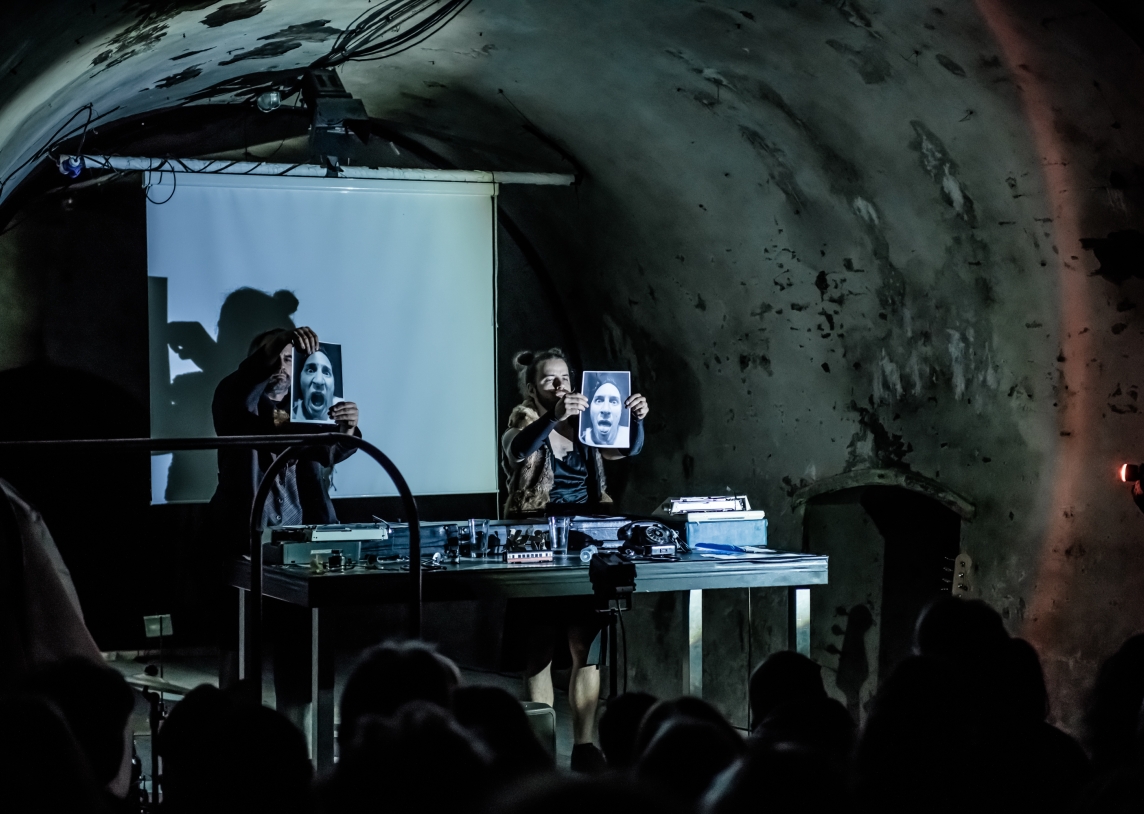- International Platform
- Content
Content
Opening of the main hall of the Vilnius Theatre “Lėlė”. On Ljubljana Puppet Theatre's performance “Session Bulgakov”
Author: Greta Vilnelė
Translated by Laima Bezginaitė
On October 27, the Vilnius Theatre “Lėlė” celebrated its sixty-fourth anniversary. To celebrate this solemn anniversary, the main hall was opened after its reconstruction and the performance for adults “Session Bulgakov” (directed by Matija Solce) of the Ljubljana Puppet Theatre was performed there. Since in Lithuania there is a lack of professional and high-quality object theater (for example, the “Lėlė” theatre has only 4 object theatre performances out of 37 shown, and in Vilnius only more than 10 object theatre performances have been created outside of “Lėlė” during the last decade), the Slovenian performance seems worthy a deeper critical analysis.
The plot of the performance “Session Bulgakov” is based on the novel “The Master and Margarita” by Ukrainian writer Mikhail Bulgakov, and in its scenery one can see hints of the writer’s own biography. Director Solce stages Bulgakov’s intertextual philosophical novel by setting a distance that allows him to create a whimsical, comical spectacle. The classical work is viewed from an unexpected perspective: the plot becomes a space for experimenting not by retelling the clearest, most easily staged parts of the work, but rather by trying to reproduce the circumstances in which they were created. The purpose of the fictional and conditional world created on the stage is to show the novel through the eyes of the writer, from within the tower of Bulgakov’s chaotic thought process.
The crowd rushing into the hall was met by white, thin disposable overalls hanging on the entrance. Each viewer got to touch the soft, light fabric before sitting down on a comfortable chair. And this way from the very beginning, hints are created not only about Bulgakov’s ghostly creative session, but also about the performance’s artistic means highlighting the importance of materiality. In the work full of elements of clownery, paper cutouts become the silhouette of a mysterious man. The portraits of the suspects printed on paper become a means for figuring out the killer. Actors animate these portraits by piercing holes for eyes, nose or mouth, and by using them as masks. The actor tells the story while leaning on a wide clothes hanger, and as he gestures, on the back of the clothes hanger a deceptive extension of his arm suddenly emerges. One more admirably resolved scene is the story about Christ’s suffering. The Stations of the Cross are revealed picture by picture as the actor unrolls a huge roll of paper. The act of unrolling is rushed by other actors, thus changing the etude of melancholically consistent storytelling into a report from, it seems, a running marathon. The momentum gained and the immediately changing form caused uncontrollable laughter and applause in the audience hall.
It is astonishing how skillfully the Slovenian actors used the objects on the stage. Through the power of imagination, they bring to life the most inert voiceless objects, such as, for instance, a white mannequin’s head with a wreath of Caesar’s laurel leaves, scraps of paper, and photographs. And many of the humor strategies used in the performance are not entirely new and can be recognized from adventure and fantasy films for children, but the idea of directing them at an adult audience lays the foundations of a nostalgically close stage expression.
The surreal magic of Bulgakov’s work is brought to life on stage not by realistic elements of expression, however, the belief in artistic reality and bursts of energy of the Slovenian actors (Gašper Malnar, Miha Arh, Filip Šebšajevič) dressed in caricature costumes effectively activate the audience’s imagination and transport them into the universe of impossibilities. The stage image of the actors is truly stunning. Let’s start with the fact that all three men have their long hair tied in buns (one actor even has two), and their lush mustaches are stylishly curled. Two actors are wearing heavy coats with stylish waistcoats underneath. Meeting such types in Moscow at the beginning of the 20th century would not be surprising at all. The third actor somewhat falls out of the trio’s context - he is a bit more ironic, like a cartoon character: dressed in a skirt, long black stockings, a corset, and a fur vest. It is easy to believe in the artistic reality, because it is acted in a naive, open-hearted manner, which we would normally see only in performances for children. It is said that it is much more difficult for actors to engage children and act for them, so this seems to be done in order to ensure that the snobbish adult audience will not remain indifferent.
The performance “Session Bulgakov” is full of live music. On the stage there is a set of drums and a guitar. A peculiar soundscape is also created by pings of as many as several typewriters, informing about the beginning of a new line. Musical interludes support the rhythm of the performance, preventing the audience from taking a break. The drummer’s rap suddenly emerges from the ensemblic chanting of the text, and the chords of the guitar are best matched in the Lithuanian context by the rock version of the sounds of the film "Bremen Musicians" by the actors of “Keistuolių teatras”.
The opening of the main hall of the “Lėlė” theatre was accompanied by a powerful charge of energy. Hopefully, the baton of effective, modern puppet or object theatre performances started by the Slovenians will be taken over by local creators, and we will see more enchanting spectacles in the cozy, freshly painted hall.
This publication is written in the context of the project "European Contemporary Puppetry Critical Platform"

